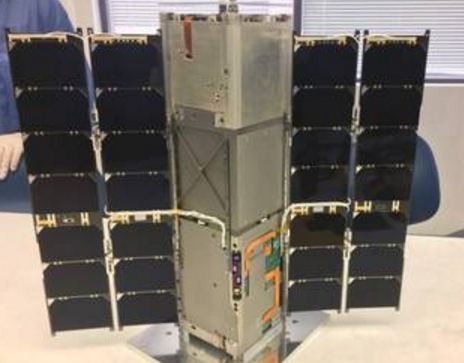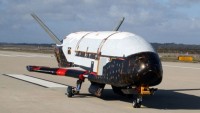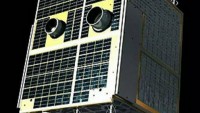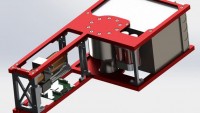NASA to launch Six Small Satellites that will take a Fresh Look at the Earth and its Weather
| Arthur Dominic Villasanta | | Nov 09, 2016 10:24 PM EST |
(Photo : NASA) The RAVAN CubeSat.
Starting November, NASA will launch six new next-generation Earth-observing small satellites to foster cost-effective and innovative new approaches to studying our ever-changing planet.
These small satellites range in size from a loaf of bread to a small washing machine and weigh from a few kilograms to 180 kg. Their small size keeps development and launch costs down since these small satellites (of which cube satellites or CubeSats are among the most popular) often hitch a ride to space as a "secondary payload" on another mission's rocket.
Like Us on Facebook
NASA is increasingly using small satellites to tackle important science problems across its mission portfolio.
"They also give us the opportunity to test new technological innovations in space and broaden the involvement of students and researchers to get hands-on experience with space systems," said Thomas Zurbuchen, associate administrator of NASA's Science Mission Directorate in Washington.
Small-satellite technology has led to innovations in how scientists approach Earth observations from space. These new missions, five of which are scheduled to launch during the next several months, will debut new methods to measure hurricanes, Earth's energy budget, aerosols, and weather.
"NASA is expanding small satellite technologies and using low-cost, small satellites, miniaturized instruments, and robust constellations to advance Earth science and provide societal benefit through applications," said Michael Freilich, director of NASA's Earth Science Division in Washington.
These small satellites are the RAVAN CubeSat; CYGNSS microsat; IceCube, HARP, MiRaTA and TROPICS.
The RAVAN CubeSat set to launch this month will demonstrate new technologies for measuring Earth's energy balance, a key factor in climate studies.
RAVAN, (Radiometer Assessment using Vertically Aligned Nanotubes) will demonstrate new technology for detecting slight changes in Earth's energy budget at the top of the atmosphere.
These are essential measurements for understanding greenhouse gas effects on climate. RAVAN is led by Bill Swartz at the Johns Hopkins Applied Physics Laboratory in Laurel, Maryland.
In spring 2017, two CubeSats are scheduled to launch to the International Space Station for a detailed look at clouds. Data from the satellites will help improve scientists' ability to study and understand clouds and their role in climate and weather.
One of these is IceCube developed by Dong Wu at NASA's Goddard Space Flight Center in Maryland. IceCube will use a new, miniature, high-frequency microwave radiometer to measure cloud ice.
The other called HARP (Hyper-Angular Rainbow Polarimete), developed by Vanderlei Martins at the University of Maryland Baltimore County in Baltimore, will measure airborne particles and the distribution of cloud droplet sizes with a new method that looks at a target from multiple perspectives.
Another small satellite, this one named MiRaTA (Microwave Radiometer Technology Acceleration mission) is scheduled to launch into space in early 2017 with the National Oceanic and Atmospheric Administration's Joint Polar Satellite System-1.
MiRaTA packs many of the capabilities of a large weather satellite into a spacecraft the size of a shoebox, said principal investigator Kerri Cahoy from the Massachusetts Institute of Technology in Cambridge.
MiRaTA's miniature sensors will collect data on temperature, water vapor and cloud ice that can be used in weather forecasting and storm tracking.
RAVAN, HARP, IceCube, and MiRaTA CubeSat missions are funded and managed by NASA's Earth Science Technology Office (ESTO) in the Earth Science Division. ESTO supports technologists at NASA centers, industry, and academia to develop and refine new methods for observing Earth from space, from information systems to new components and instruments.
"The affordability and rapid build times of these CubeSat projects allow for more risk to be taken, and the more risk we take now the more capable and reliable the instruments will be in the future," said Pamela Millar, ESTO flight validation lead.
"These small satellites are changing the way we think about making instruments and measurements. The cube has inspired us to think more outside the box."
NASA's early investment in these new Earth-observing technologies has matured to produce two robust science missions, the first of which (CYGNSS) is set to launch in December.
CYGNSS (Cyclone, Global Navigation Satellite System) will be NASA's first Earth science small satellite constellation. Eight identical satellites will fly in formation to measure wind intensity over the ocean, providing new insights into tropical cyclones.
Its novel approach uses reflections from GPS signals off the ocean surface to monitor surface winds and air-sea interactions in rapidly evolving cyclones, hurricanes, and typhoons throughout the tropics. CYGNSS, led by Chris Ruf at the University of Michigan, Ann Arbor, is targeted to launch on Dec. 12 from Cape Canaveral Air Force Station in Florida.
Earlier this year NASA announced the start of a new mission to study the insides of hurricanes with a constellation of 12 CubeSats.
TROPICS (Time-Resolved Observations of Precipitation structure and storm Intensity with a Constellation of Smallsats) will use radiometer instruments based on the MiRaTA CubeSat that will make frequent measurements of temperature and water vapor profiles throughout the life cycle of individual storms. William Blackwell at the Massachusetts Institute of Technology Lincoln Laboratory in Lexington leads the mission.
TagsNASA, CubeSats, cube satellites, small satellites, micro satellites, RAVAN, CYGNSS, IceCube, HARP, MiRaTA, tropics
©2015 Chinatopix All rights reserved. Do not reproduce without permission
EDITOR'S PICKS
-

Did the Trump administration just announce plans for a trade war with ‘hostile’ China and Russia?
-

US Senate passes Taiwan travel bill slammed by China
-

As Yan Sihong’s family grieves, here are other Chinese students who went missing abroad. Some have never been found
-

Beijing blasts Western critics who ‘smear China’ with the term sharp power
-

China Envoy Seeks to Defuse Tensions With U.S. as a Trade War Brews
-

Singapore's Deputy PM Provides Bitcoin Vote of Confidence Amid China's Blanket Bans
-

China warns investors over risks in overseas virtual currency trading
-

Chinese government most trustworthy: survey
-

Kashima Antlers On Course For Back-To-Back Titles
MOST POPULAR
LATEST NEWS
Zhou Yongkang: China's Former Security Chief Sentenced to Life in Prison

China's former Chief of the Ministry of Public Security, Zhou Yongkang, has been given a life sentence after he was found guilty of abusing his office, bribery and deliberately ... Full Article
TRENDING STORY

China Pork Prices Expected to Stabilize As The Supplies Recover

Elephone P9000 Smartphone is now on Sale on Amazon India

There's a Big Chance Cliffhangers Won't Still Be Resolved When Grey's Anatomy Season 13 Returns

Supreme Court Ruled on Samsung vs Apple Dispute for Patent Infringement

Microsoft Surface Pro 5 Rumors and Release Date: What is the Latest?














